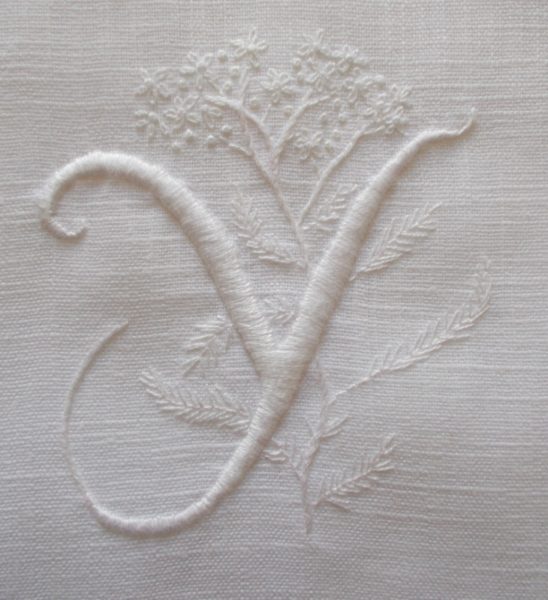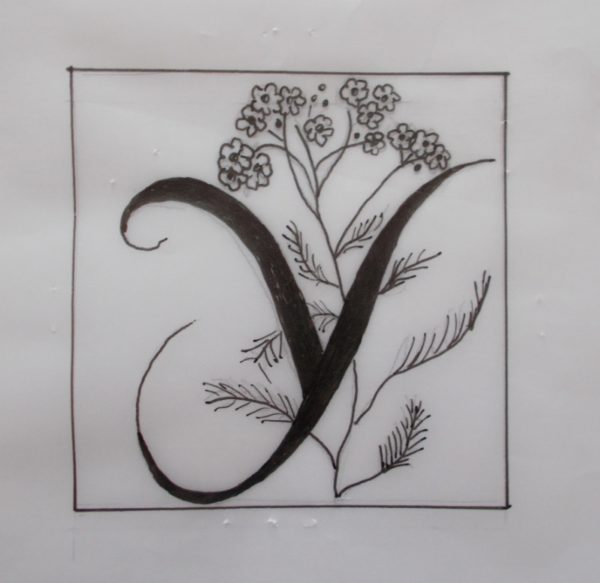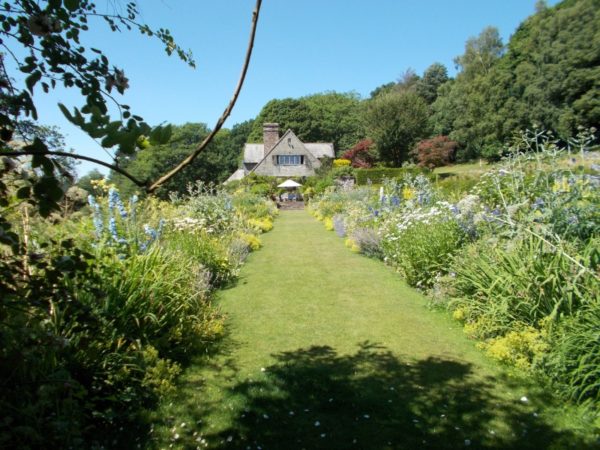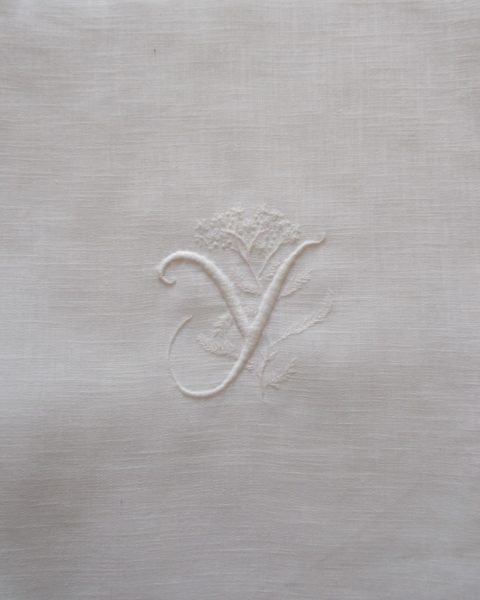
Y is for yarrow, a whitework alphabet (hand embroidered by Mary Addison)
Yarrow will make itself very much at home in gardens if it likes the conditions – and it was obviously very happy in the vicarage garden at Ipsden where it would pop up all over the place, not often exactly always where you would like it to, though it has to be said, it was quite easy to remove. After a while, I came to welcome the ferny leaves topped by creamy white platters of cauliflower-like florets for the way they poked up above the leafy hostas and heucheras which also tolerated life on the thin chalk soil. But isn’t naming a funny business? Looking into yarrow, it came up that it’s binomial name is Achillea millefolium and I remembered back 15 years when I was homeless and living with friends in Monmouth as I tried to buy a flat in the town.

Y is for yarrow, a whitework alphabet (hand embroidered by Mary Addison)
My friend had a beautiful but run down historic garden whose bare bones she was restoring to their glory days of the 1920s. Stone piers stood straight but no longer carried the 40 ft lengths of oak that made up the pergola, the woodland walks were heavily overcome with brambles and other colonising plants and the yew hedges backing deep floral borders were notable for their almost complete absence. Worse of all in terms of historical accuracy, a previous owner had built a swimming pool across a third of the flat parterre that led from the house to the pergola. In spite of the swimming pool having no planning permission, planners allowed it to remain – much to the grief of my friend’s husband who hated it and would have dug it up single handedly with the slightest justification. (But being a pragmatic chap he knew other things needed doing first.) From the point of view of the swimmer it was in fact one of the most beautifully sited swimming pools in the world (and I’m comparing it to the pool of Old Cataract Hotel which looked out over the Nile to Elephantine Island and to that of The Meena House Hotel at Giza which had the pyramids as backdrop!). My friend’s house and pool sat on a ledge near the top of an escarpment facing west. The garden then fell away into woodland bottoming out in a stream before the land rose again into a patchwork of small typically English hedge-bound fields in the middle of which sat Cwmcarvan Church – quintessential England, think Nutwood in the Rupert Bear books. (Actually it’s Wales, now. Monmouth has a complicated history having been bounced between England and Wales through much of its history.) To the south-east, beyond the fields and the scarcely visible dip suggesting the Usk valley, rose the Black Mountains, the easternmost range of the Brecon Beacons, while to the north-west the Sugar Loaf and Skirrid mountains presented their distinctive profiles. Swimming in the pool felt like you were swimming at the top of the world with all good things laid out beneath you. When I was living there, the summer was glorious. I had just had a shoulder replacement and I put full recovery of the complex movements of my shoulder joint down to regular, sometimes twice daily, swimming sessions in this little corner of paradise and the wonderful feeling of wellbeing the swimming and the spirit of the place gave me. Of course the pool had to go. It went and the herbaceous borders and the vista from house to pergola were restored. Whenever I visit I grieve for its loss – but thank it and its custodians for having been there when I needed it. (High Glanau Manor is open under the NGS scheme and sometimes for special parties of visitors.)

High Glanau Manor, Lydart, Monmouthshire. The swimming pool formerly occupied the top third of the lawn and borders above. This not very good photograph was taken in late summer when the borders’ were just over their glorious best.
Achillea, yes! It’s just that I remember my friend planting achillea with pale grey ferny foliage and little yellow flowers and then later ones with lovely coral flowers with yellow centres. It took me a long time to twig that these plants so at ease in their place in the sophistication of the herbaceous border were cultivars of the same yarrow I’d always thought of as a weed. The Spanish rather sweetly call it plumajillo, which means little feather but colloquial English names, woundwort, staunchwort and herbal militaris, hark back more to function than appearance and refer to the plant’s ancient job of healing wounds, as does the latin name Achillea which refers to the legend that the Greek hero Achilles took it into battle with him for treatment of his soldiers’ wounds. We don’t seem to use the herb much medicinally anymore, but starlings are canny enough to line their nests with yarrow and from studies on other birds which don’t routinely do this, the addition of yarrow has been shown to inhibit nest parasites. Yarrow’s nectar attracts important insects beloved of gardeners like hoverflies and ladybirds both of which help reduce garden undesirables like aphids. Predatory wasps go one step further and in exchange for deep draughts nectar they pick up and remove yarrow’s insect pests and carry them off to feed their larvae. So, not so much a weed, more a jolly useful plant!

Y is for yarrow, a whitework alphabet (hand embroidered by Mary Addison)

20 Comments
Dear Mary Addison – I’ve had a note to myself to contact you for longer than I care to remember, and this seemed the easiest way… Might I cite your Wolf Hall entry in a book I’m currently finishing, /Textile Shakespeare/? I’m using Mantel’s wonderful eye for clothing and textiles as a ‘way in’ to the introduction, and intermittently throughout… I’m not an embroiderer and my needlepoint days are long gone – but your blog, its prose and images, and not least the beautiful work that you share, are a delight!
Yes, of course, Hester, with pleasure.
Hilary Mantel animates the lowliest garment and the most unruly stitch into telling us that bit more about a character.
Never have fabric and thread spoken so eloquently!
Thank you for telling me that you enjoy the blog.
It’s always a delight to read your blog and find out what direction your curiosity or recollection has taken you!
What nice things you say, Rachel. Thank you.
Associations come unbidden as we spend more time with our own thoughts and lately I find that I plan a blog to go one way but when writing thoughts take me somewhere else entirely.
I’ve discovered that too, with my videos. I usually manage to keep written work on track, but wittering gently as I’m stitching has produced some very odd ramifications, not all of which make the final cut!
But which probably make the videos all the more fun! Don’t cut too much.
I’ve been a fan of Aquileia for years. My favorite are the huge yellow saucer blooms, although the foliage is lovely in any variety too. Thanks for sharing the estate description also. What a wonderful place to live that must have been.
Now that’s interesting. This is what we call aquilegia but we also call it columbine https://en.wikipedia.org/wiki/Aquilegia and this is what we call achillea but also yarrow https://en.wikipedia.org/wiki/Achillea_millefolium. Your blooms sound much bigger and luscious than either of these plants produce in the UK.
High Glanau is a unique place with a wonderful feeling about both house and garden – in part due to the setting but also because the people who live in it have made it a happy place to be.
Oh I was being so silly. I mistyped. Of course I love the Columbines too! Forgive my mistake please.
I find my computer autocorrects all sorts of things – it even changes my granddaughter’s name EVERY time, correcting it from Xanthe to Ianthe – now that’s extraordinary, it’s left it as I typed it (though it has underlined it rather patronisingly)!
This is the kind we have: https://www.gardenia.net/plant/achillea-filipendulina-gold-plate-yarrow
Yes, we have lots of those in England too, though I do think they look better in places with lots of sunshine.
I frequently walk by a lovely stand of yarrow in a small gravel filled bed in a parking lot – blazing sun, bad air, the works. Its happy as can be. I planted some in what I hoped was a sunny enough place, it moped for a couple years and departed. Some relationships just don’t work out. Wonderful picture of High Glanau and I can see both why you miss the pool and why it had to go. You must be hardy indeed however to swim in a British summer!
ceci
Ceci, 2005 was a beautiful long hot summer, so swimming in the pool was a double joy. I was going to say it was the year England beat Australia and won back the Ashes (cricket) but then I saw you’d written ‘parking lot’ and suddenly it struck me you might not live in the UK!
No, I am on the east coast of the US, for my sins at the moment. But I DO know about the Ashes – a book by Elizabeth George, I think.
ceci
Goodness me and only now do I know that the writer of the Inspector Lynley series is not only American but has written a thriller involving what is probably to most people (including many English) the most abstruse English sport going! Fascinating! Thank you for that Ceci.
Thank you Mary for another interesting and informative post. What a wonderful place to stay when homeless. Only one more letter to go now – have you decided what to do next?
No decision yet. I have more pieces of embroidery to post first which should give me a bit more time to do more research and more thinking.
That is such a Beauty.
Thank you Louise.